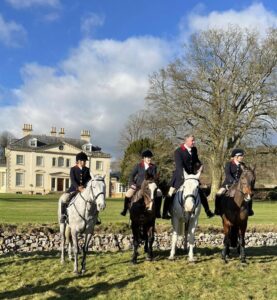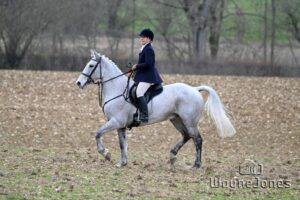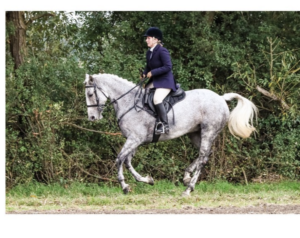Here you will find the most common questions we are asked.
Please contact our Hon Secretaries if you are still not certain about any aspect of draghunting with us.
Please ensure you have carefully read and fully understood our Code of Conduct before you come out draghunting with us.
Trail hunters often say they ride in order to hunt. With draghunting, we draghunt to ride.
Riding with the drag is a thrilling sport which should not be confused with trail hunting which, follows an animal based scent and simulates traditional hunting
With a draghunt, a pack of hounds follow an artificial scent (perfume, aniseed, oil and water) laid by a human (on foot, from horseback or on a quad bike) over a pre-determined route agreed with the landowner and shared with the Huntsman in advance. We jump all obstacles offered by the country crossed – even adding some to keep the day exciting! When laying a line we take advantage of the best opportunities for seeing the hounds work too.
WHAT HAPPENS?

Victoria Ruffy MDH, Amy van Oostrum, Andrew van Oostrum MDH and Kate Honey MDH at the Meet at Rockley Manor
The meet starts at 12.30pm so you need to arrive in plenty of time to be mounted and ready to ride at 12.30pm.
If it is a lawn meet drinks will be offered by the host. Before moving off, the Master for the day will inform the followers (the ‘Field’) of anything they need to know about the lines, the day in general and any ‘parish notices’.
You should find out who the Fieldmaster is (you should not go in front of this rider). The hounds will then move off and when they pick up the scent and start to run, the rest of the field follows jumping fences along the way. At the end of the line, there will be a fifteen minute break to allow the horses and riders to recover before the second line begins. A normal meet has three or four lines covering up to 1 1/2 to 2 miles each but riders can miss out a line if they feel it will be too much for their horses. At the end of the day there will often be tea at the meet too.
Please wait until our Huntsman has put the hounds away before you dismount to head back to your boxes. If you want to leave early find a Master and let them know. The traditional goodbye is to say “Goodnight Master” regardless of the time of day.
WHAT SORT OF HORSE DO I NEED?
All sorts of horses and ponies come out draghunting. You don’t have to have a fast horse, but for big days you do need one capable of jumping at least 2’9″ and they should always be neatly and safely turned out.
However generally, none of the fences are mandatory and you may be able to have a great day without jumping at all.
Meets vary in the difficulty of the fences offered and the terrain and it is easy to see from the meet card and any Facebook posts those which are suitable for novice horses or riders.
You should make sure your horse is fit before coming out and put a green ribbon in its tail if it hasn’t been draghunting before so other riders know it is inexperienced. (If you have any concern that your horse might kick, you should always have a red ribbon in its tail and ride in an appropriate position in the Field. If your horse kicks you may be asked to go home. It is your job to keep your horse away from other horses.
WHAT DO I WEAR?
To be completely correct wear a black or navy (for ladies) jacket with a white or cream stock, black boots and spurs. Navy coats with red collars and four gold buttons are only worn by Masters, with five buttons for draghunt staff. Those with red collars and black buttons are members of the Field who have been awarded their draghunt buttons – great people to ask advice from if you are in a pickle.

A great example of expected smart turnout levels from the Field from Victoria Ruffy MDH
As with any cross country riding, you should make sure you wear the best hat available, with a black or navy cover to match your jacket and back protectors are advisable. Ladies’ hair should always be neat in a hairnet, long hair can be put in a bun.
Horses should be plaited after the Opening Meet unless the meet card says otherwise.
Some meets are deemed ‘ratcatcher’ which means no need to plait, tweed/black/blue jackets with a coloured stock or tie, fawn jodhpurs or breeches and brown boots with spurs. Masters will wear tweed with navy collars.
WHAT SHOULD MY HORSE WEAR?

Victoria Ruffy MDH on Delta
Well fitting, plain tack of good strong leather with a general purpose or jumping saddle. A good comfortable numnah to match your horse in a dark colour (black, brown or blue) which is breathable may prove helpful as your horse may sweat a lot and you will be in the saddle for several hours.
Use a stronger bit than you would normally ride your horse in. It’s much safer for all concerned and far better mannered to be able to stop or turn your horse quickly if there is a check or change of direction. A breastplate is a good idea to ensure the saddle does not move and for extra grip so you don’t catch your horse run the mouth. Brushing boots may become loose or wet and filled with mud which could chafe your horse.
Coloured saddle cloths, sparkly or coloured browbands may look good for dressage or show jumping but they are not correct for draghunting!
As your horse will work very hard it is sensible to ensure your horse is clipped.
A very clean, tidy and neatly groomed horse is a must. Please don’t come out with a stained, muddy or dirty horse as it is very disrespectful to our landowners who grant us access to cross their country. It is also important tack is clean from an aesthetic point of view as well as for safety reasons. Dry and dirty tack often breaks!
HOW MUCH DOES IT COST?
There are various and flexible ways that you can pay for a days draghunting ranging from a single full/day cap to a year’s subscription that enable you to be out every time the hounds are.
Please see our Subscriptions & Caps page for further & full details.
OUR GOVERNING BODY
The Berks and Bucks Draghounds are proud members of the Masters of Draghounds and Bloodhounds Association (MDBA). We are in no way associated of affIliated with the British Hound Sports Association (BHSA).
